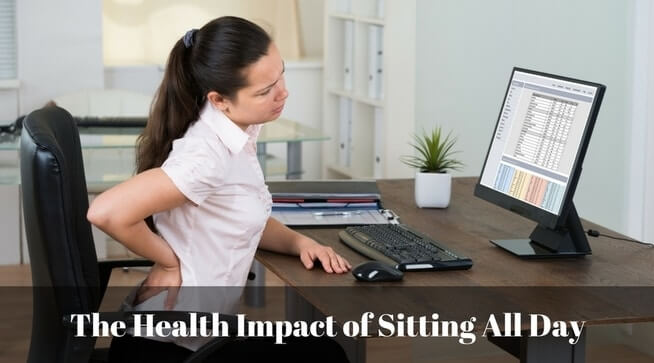The Health Effects of Sitting All Day
Health & Safety Tips
•
Oct 9, 2017
Reviewed by: Jeffrey Peebles, M.D

Sitting is an unavoidable part of life for most people. From children sitting at their desks in school for seven or eight hours a day to adults who begin their day with a commute that involves sitting in their car or public transportation while heading to an office where they’ll sit in a cubicle all day before their commute home. At home our favorite pastimes generally involve sitting, whether that’s watching TV, playing video games or surfing the internet.
This is a dramatic shift from the majority of human history. From hunter gatherers to agrarian societies, ancient people were on their feet all the time. Even for a large part of the 20th century, people had manufacturing jobs and other occupations that often had them on their feet and moving about to produce products or provide services.
A study performed by the University of Texas School of Public Health surveyed marathoners, a group you may assume bucks the trend of chronic sitters, about their sedentary habits. Even these healthy, active individuals, who boasted a median training time of 6.5 hours a week, admitted to sitting an average of 8 to 10.75 hours each day. Author and scientist Katy Bowman describes these people as “actively sedentary” and posits an hour of exercise a day doesn’t offset the negative effects of sitting for 10 hours a day.
7 Health Effects of Sitting All Day
1. Heart Disease
Lifestyles that involve excessive sitting have been tied to increased risks for heart disease. The longer we sit the less fat muscles burn. Blood also flows more slowly without an elevated heart rate. The end result is fatty acids have more of an opportunity to clog the heart. Studies have shown people with a sedentary lifestyle can be twice as likely to develop heart disease.
2. Diabetes
Inactive muscles are less effective at processing insulin, a hormone essential for converting sugar into energy. The sluggish processing leads the body to believe more insulin is required, resulting in insulin overproduction, which can ultimately contribute to diabetes.
3. Certain Types of Cancer
Although seemingly unrelated, excessive sitting has been linked to an increased likelihood of developing certain types of cancer, including colon, breast and uterine cancer.
4. Muscle Degeneration
Unsurprisingly, a lack of movement also significantly contributes to muscle degeneration. You may be surprised at how much good even the seemingly easy activity of standing is for your ab muscles, which are constantly in use when standing upright. The lack of movement also causes hip muscles to become shorter and tighter, diminishing range of motion. Similarly, your glutes do nothing when you’re sitting in a chair, so they also suffer the degenerative side effects of being underworked.
5. Poor Circulation
Exercising, even gently, causes the heart to pump faster, resulting in accelerated circulation. Given the nature of the heart and circulation, it’s no surprise that sitting all day means your blood is running slower, reducing circulation and potentially contributing to issues such as varicose veins and deep vein thrombosis (DVT).
6. Decreased Brain Health
Exercise and movement are actually valuable for your brain health as well. An elevated heart rate and improved circulation means more oxygenated blood is going to your brain. Exercising also releases brain and mood-improving chemicals, which can also contribute to healthy brain function.
7. Less Flexibility
Sitting all day can take a toll on your neck and back, especially if you don’t have ideal sitting posture. Even something you don’t think about, like holding your phone to your ear by cradling it between your head and shoulder, can significantly strain your vertebrae. Movement is also essential for the elasticity of the spine. When you move the spongy discs between your vertebrae expand and contract, absorbing fresh blood and nutrients in the process. The lack of absorption ultimately results in less flexibility.
What Can I Do?
All that sounds very disheartening. You may be able to adjust your leisure-time habits to incorporate more activity, but what can you do about sitting at work? There are fortunately some relatively easy solutions for people whose jobs require them to sit for the majority of the day.
A 2014 study performed by Indiana University found that interspersing three five-minute walks in a three-hour sitting session offsets the negative impacts of sitting on leg arteries. Although there are health risks beyond just circulation and leg arteries, the idea that brief bouts of even relaxed physical activity, such as a slow walk, can mitigate the effects of an otherwise sedentary lifestyle should be cause for optimism.
If sitting is simply unavoidable you can at least do your best to optimize your posture. The ideal sitting posture is straight-backed with elbows bent at 90 degrees and feet flat on the floor. Try to choose chairs with good lower back support and avoid leaning forward or slouching.
You can also ask your HR department to purchase exercise balls in lieu of chairs. Even a backless chair can have some of the same benefits. When your body has to balance or work to sit up straight you are actually exercising your core muscles to stay upright.
Learn More About Staying Healthy and Active with Complete Care
The primary care physicians at Complete Care can be your partner in developing healthy habits to help offset the negative effects of an otherwise sedentary lifestyle. From our ER doctors and specialists to our urgent care doctors and nurses, you can rely on Complete Care for any and all of your general health care needs. Find a location near you to schedule an appointment!
Sources
https://www.reuters.com/article/us-fitness-walking-idUSKCN0HO0PV20140929
https://archive.news.indiana.edu/releases/iu/2014/09/slow-walking-sitting-study.shtml
